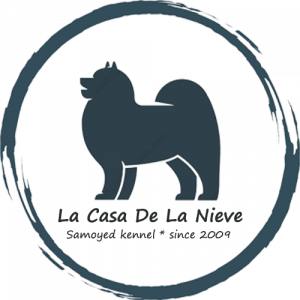Ears grooming
Your Samoyed’s ears should be checked on a regular basis for mites, infections such as yeast (may notice a brownish black substance inside the ears or reddening), ticks, fleas, etc. If you notice your dog shaking his head there could be a problem in the ears. Head shaking can cause an Auricular Hematoma so it is important in more ways than one to have your dog’s ears checked by your veterinarian if this occurs. In brief, a hematoma is a fluid-filled swelling that develops on the surface of the pinna in dogs from head shaking or ear scratching. The condition is common in dogs. There are other problems that can cause hematomas, but for our purposes here we will address the ears. Treatment is surgical to allow drainage. For normal regular care of the ears, my vet suggests that cleaning the outer inside base of the ear (the part you can see) with a dry soft cloth is sufficient for my dogs. It is not recommended that you stick your fingers down into the dog’s ear canal or use Q-Tips down inside the ear canal. Using Q-Tips down into the ear canal can cause damage to the ear. Some owners will use a mixture of vinegar, alcohol and water to clean the inside base of the ears and that is okay but would check with your veterinarian first for use with your dog. Your vet may recommend that you periodically use a rinsing solution followed by drying flush to clean further down into the ears.
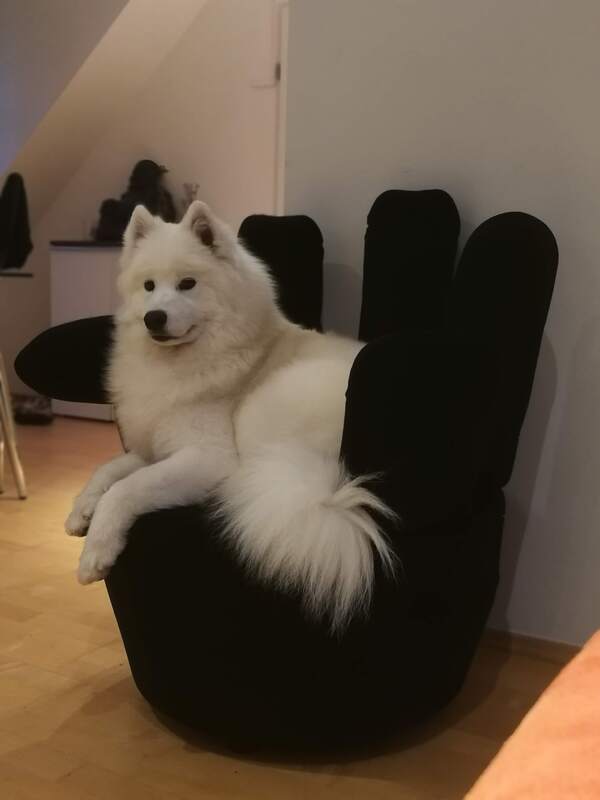
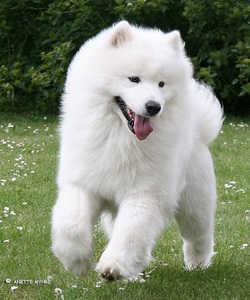
Hocks grooming
I generally trim the hocks/rear pasterns and do feet while my dogs are lying down in front of the TV. With the dog lying on his/her left side I first comb out the coat on the hock thoroughly using my Greyhound comb (small tooth end). I line comb down towards the paw, then I line comb up towards the point of hock, but do not forget to comb the point of hock also. Time and energy permitted, I will also sometimes line comb the hock and rear pastern area coat from side to side. Now, with the dog’s hock supported in my left hand (I am right handed so do not know if left handed people do this differently) I will comb all the coat on the hock, from the point of hock to the pad towards the floor (to the right side). Once all the coat is combed towards the direction of the floor, I slightly rotate the hock in my left hand towards me so that I now can see that right side using the imaginary line which can be seen from approximately the fibula bone down to the side of the pad. I will trim the coat starting at the side of the point of hock down towards the beginning of the pad area. I personally use scissors to do this, but many people use thinning shears instead. This is another one of those personal choices. The reason most people use thinning shears versus scissors is because it is felt that the thinning shears leave a more natural look. I suggest thinning shears for sure until you get the hang of it. Plus, until you get used to doing this area I would recommend trimming a little at a time to avoid cutting too short. After this side is complete, I will then line comb all the coat to the opposite side (left) and repeat the procedure just like you did to the right side of the hock. After both sides are complete, I will again line comb the entire hock coat down towards the pad and then up towards the point of hock, and out. It is an up and out type of stroke with the comb this time. You can look at the coat on the hock and touch up any stragglers. Now, you can do the other hock. Some will trim hocks with their dog up on the grooming table. Basically, after completely line combing the hock coat out they will set the dog’s foot evenly with the end of the table. Then holding the thinning shears vertically to the ceiling they will trim from the back starting at the bottom of the paw upwards towards the dog’s point of hock. Again, with the thinning shears being held vertically to the ceiling. They usually start with the middle section of the hock until they get the hock trimmed how they would like followed by doing the right and left sides of the same hock. I suggest consulting with someone who uses this method prior to trying it.
Feet grooming
To add on the feet/pads, try to cut your dog’s nails at least once a week and no longer than once every two weeks. This will greatly depend on how fast your dog’s nails grow. As with people, some dogs nails grow much faster than others do. Letting toenails grow too long can cause many problems including difficultly with gait. If you can hear your dog’s nails clicking as they walk across the linoleum, hardwood floors, concrete, etc. they are too long. The nails should be trimmed as close as possible. With clear nails the quick can easily be seen, but is more difficult to the inexperienced owner on those black toenails. You will notice on the under side of your dog’s nail it makes sort of a “V” shape. This can sometimes be a good indicator on those darker nails. Until you feel comfortable clipping the nails without quicking them it may be a good idea to have your veterinarian or tech do them for you, have more experienced friends do them, or be assisted the first couple of times by someone more experienced. There is a product called Kwik-Stop, which is sold, in most pet stores. This product is a septic powder that you can apply to a quicked nail to prevent bleeding. There are other products for this as well. Always check the coat in between the pad/toes on top and bottom for dried mud that may have harden and feel like rock, thorns, stickers, etc. once a week if not more often. These things can cause a lot of pain and discomfort for your dog. Also, I know some owners live in areas where foxtail are a problem. The feet are especially important to keep up on your Samoyed. Feet are a vital part of the dog’s body.
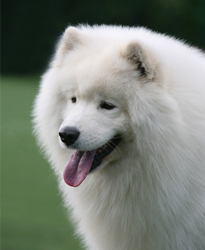
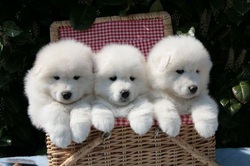
Teeth grooming
Clean and check your dog’s teeth often for tartar build up, redness of the gums or gum line, chipped/split/cracked or broken teeth. Also, for any foreign object that could be stuck in between the teeth or gum line, etc. I personally prefer to have my vet clean my dog’s teeth. However, many owners do clean their own dog’s teeth using a scaler and some follow up with a polisher if they own one. Even if you scale your own dog’s teeth it is a good idea to have your vet or tech do the teeth ever so often. Polishing the teeth after cleaning/scaling is important. One thing we can all do is brush our dog’s teeth on a daily or as often as possible basis. Most vet offices, pet stores, catalogs, etc. sell dog toothpaste and tooth brushes. You may prefer one of the finger type toothbrushes. Some owners will use baking soda and water for the teeth versus dog toothpaste. Again, check with your veterinarian on what he/she thinks is best for you and your dog. Consult with them prior to using a human brand of toothpaste. Keep in mind that gum disease, bad breath or excessive build up of tartar could signify other primary problems which should be addressed and treated.
For more general information regarding pet dental care click HERE.
